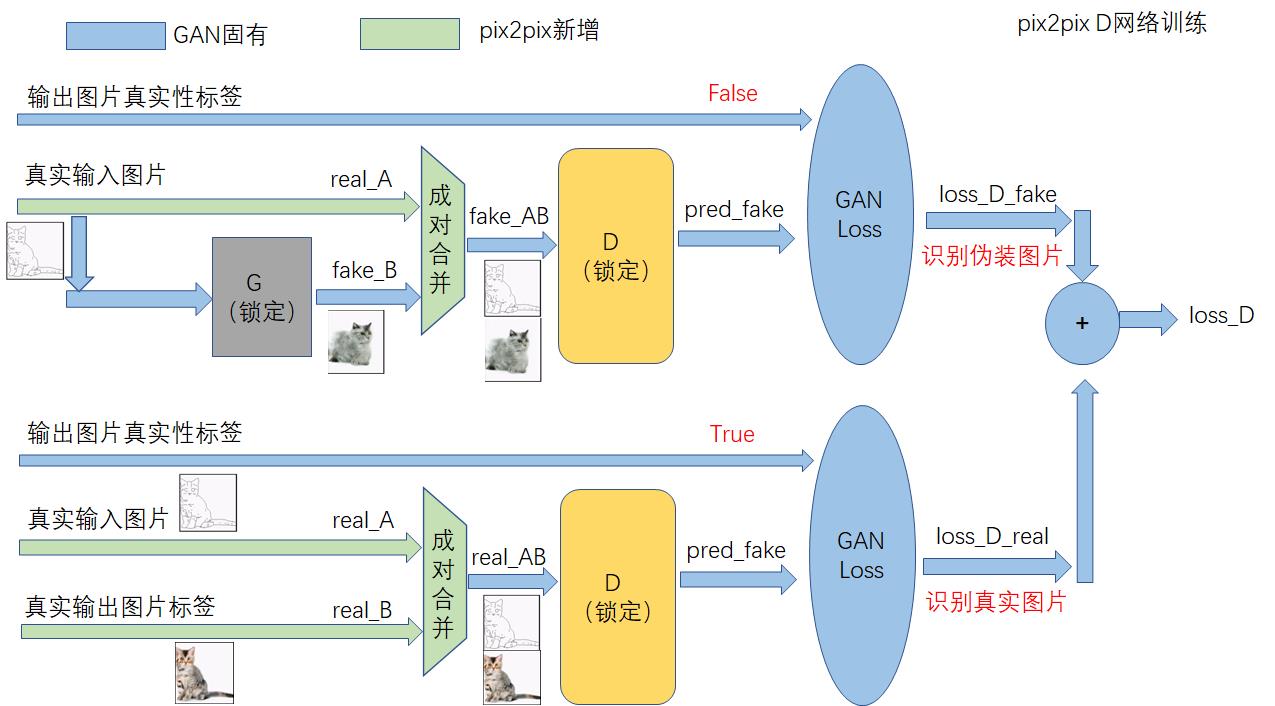[Pytorch系列-74]:生成对抗网络GAN - 图像生成开源项目pytorch-CycleGAN-and-pix2pix - pix2pix网络结构与代码实现详解
Posted 文火冰糖的硅基工坊
tags:
篇首语:本文由小常识网(cha138.com)小编为大家整理,主要介绍了[Pytorch系列-74]:生成对抗网络GAN - 图像生成开源项目pytorch-CycleGAN-and-pix2pix - pix2pix网络结构与代码实现详解相关的知识,希望对你有一定的参考价值。
作者主页(文火冰糖的硅基工坊):文火冰糖(王文兵)的博客_文火冰糖的硅基工坊_CSDN博客
本文网址:https://blog.csdn.net/HiWangWenBing/article/details/122101231
目录
第1章 网络的定义
1.1 网络结构

相对于基础型的GAN网络,pix2pix网络,并没有增加新的网络结构,只在基础型的GAN基础上做了如下的优化:
- 判决网络的输入:增加了输入图片,与输出fake图片一起参与判决
- 判决网络的输出:不仅仅需要参与判决网络的判决,还需要与样本标签图片进行像素级的比较。
1.2 代码来源
pytorch-CycleGAN-and-pix2pix\\models\\pix2pix_model.py
1.3 网络结构代码解读
def __init__(self, opt):
"""Initialize the pix2pix class.
Parameters:
opt (Option class)-- stores all the experiment flags; needs to be a subclass of BaseOptions
"""
BaseModel.__init__(self, opt)
# specify the training losses you want to print out. The training/test scripts will call <BaseModel.get_current_losses>
self.loss_names = ['G_GAN', 'G_L1', 'D_real', 'D_fake']
# specify the images you want to save/display. The training/test scripts will call <BaseModel.get_current_visuals>
self.visual_names = ['real_A', 'fake_B', 'real_B']
# specify the models you want to save to the disk. The training/test scripts will call <BaseModel.save_networks> and <BaseModel.load_networks>
if self.isTrain:
self.model_names = ['G', 'D']
else: # during test time, only load G
self.model_names = ['G']
# define networks (both generator and discriminator)
self.netG = networks.define_G(opt.input_nc, opt.output_nc, opt.ngf, opt.netG, opt.norm,
not opt.no_dropout, opt.init_type, opt.init_gain, self.gpu_ids)
if self.isTrain: # define a discriminator; conditional GANs need to take both input and output images; Therefore, #channels for D is input_nc + output_nc
self.netD = networks.define_D(opt.input_nc + opt.output_nc, opt.ndf, opt.netD,
opt.n_layers_D, opt.norm, opt.init_type, opt.init_gain, self.gpu_ids)
if self.isTrain:
# define loss functions
self.criterionGAN = networks.GANLoss(opt.gan_mode).to(self.device)
self.criterionL1 = torch.nn.L1Loss()
# initialize optimizers; schedulers will be automatically created by function <BaseModel.setup>.
self.optimizer_G = torch.optim.Adam(self.netG.parameters(), lr=opt.lr, betas=(opt.beta1, 0.999))
self.optimizer_D = torch.optim.Adam(self.netD.parameters(), lr=opt.lr, betas=(opt.beta1, 0.999))
self.optimizers.append(self.optimizer_G)
self.optimizers.append(self.optimizer_D)
- train模式下需要定义G + D网络, 而在测试或预测模式下,只需要定义G网络。
- 只有在训练模式下,才需要定义loss和优化算法。
1.4 输入数据集处理代码解读
def set_input(self, input):
"""Unpack input data from the dataloader and perform necessary pre-processing steps.
Parameters:
input (dict): include the data itself and its metadata information.
The option 'direction' can be used to swap images in domain A and domain B.
"""
AtoB = self.opt.direction == 'AtoB'
self.real_A = input['A' if AtoB else 'B'].to(self.device)
self.real_B = input['B' if AtoB else 'A'].to(self.device)
self.image_paths = input['A_paths' if AtoB else 'B_paths']- pix2pix网络采用的是成对数据集(paired数据集),这个数据集是把两个图片按照字典的方式组合在一起的,因此需要先把他们分离开来。
- real_A: 真实的输入图片。
- real_B: 真实的标签图片 (标签不一定是分类的数值,也可以是一张图片)
1.5 前向运算
def forward(self):
"""Run forward pass; called by both functions <optimize_parameters> and <test>."""
self.fake_B = self.netG(self.real_A) # G(A)- 前向运算只使用G网络,创造或生成图片。
- 前向运算的输入是真实图片Real_A,输出是生成图片fake_B, 与生成图片对应的是真实图片Real_B.
- 如果仅仅是测试训练好的模型,有前向运算就可以了,不需要训练。
第2章 网络的训练
1.1 G生成网络的结构与代码解读
(1)G网络的训练架构

- 在训练G网络时,需要锁定D网络。
(2)G网络Loss代码实现
def backward_G(self):
"""Calculate GAN and L1 loss for the generator"""
# First, G(A) should fake the discriminator
# 组合real_A和fake_B
fake_AB = torch.cat((self.real_A, self.fake_B), 1)
# 组合后图让锁定后的D网络进行判决
pred_fake = self.netD(fake_AB)
# 通过调整G网络,期望能够骗过D网络,即预测值接近True(1)
self.loss_G_GAN = self.criterionGAN(pred_fake, True)
# Second, G(A) = B
# 确保生成图片fake_B, 不仅仅能够骗过D网络,还需要与标签图片real_B接近。
# 反应在代码上,采用的像素点的绝对值差L1 loss来实现的。
self.loss_G_L1 = self.criterionL1(self.fake_B, self.real_B) * self.opt.lambda_L1
# combine loss and calculate gradients
# 最终的目标组合上述两个loss,优化算法使得组合后的loss最小。
self.loss_G = self.loss_G_GAN + self.loss_G_L1
# 反向求导,求G网络所有参数的梯度
self.loss_G.backward()1.2 D判决网络的结构与代码解读
(1)D网络的训练架构

(2)D网络Loss代码实现
def backward_D(self):
"""Calculate GAN loss for the discriminator"""
# Fake; stop backprop to the generator by detaching fake_B
# we use conditional GANs;
# we need to feed both input and output to the discriminator
# 合并输入图片real_A和生成图片fake_B
fake_AB = torch.cat((self.real_A, self.fake_B), 1)
# 使用D网络进行判决
pred_fake = self.netD(fake_AB.detach())
# 通过调整D网络参数,需要识别出,该输出图片为"假"
# 体现在代码上,就是预测结果pred_fake与False(0) 相比
# 优化算法,使得判断结果为0
self.loss_D_fake = self.criterionGAN(pred_fake, False)
# Real
# 合并真实输入图片real_A与真实的标签图片real_B
real_AB = torch.cat((self.real_A, self.real_B), 1)
# 使用D网络进行判决
pred_real = self.netD(real_AB)
# 通过调整D网络参数,需要识别出,该输出图片为"真"
# 体现在代码上,就是预测结果pred_fake与True(1) 相比
# 优化算法,使得判断结果为1
self.loss_D_real = self.criterionGAN(pred_real, True)
# combine loss and calculate gradients
# 组合上述两种loss,并求平均
self.loss_D = (self.loss_D_fake + self.loss_D_real) * 0.5
# 反向求导,求G网络所有参数的梯度
self.loss_D.backward()1.3 pix2pix网络整体的优化算法
def optimize_parameters(self):
# 使用real_A进行前向运算,生出图片fake_B
self.forward() # compute fake images: G(A)
# update D
# 使能D网络的梯度迭代
self.set_requires_grad(self.netD, True) # enable backprop for D
# 复位D网络的梯度
self.optimizer_D.zero_grad() # set D's gradients to zero
# 计算D网络的梯度
self.backward_D() # calculate gradients for D
# 进行D网络的迭代迭代
self.optimizer_D.step() # update D's weights
# update G
# D requires no gradients when optimizing G
# 需要手工锁定D网络
self.set_requires_grad(self.netD, False)
# 复位G网梯度
self.optimizer_G.zero_grad() # set G's gradients to zero
# 计算G网络的新的梯度
self.backward_G() # calculate graidents for G
# G网络迭代迭代
self.optimizer_G.step() # udpate G's weights- 先优化判决网络D,鉴别出真假
- 然后优化生成网络G, 骗过优化后的D网络
- 然后在优化判决网络D,鉴别出真假
- 依次类推,不断对抗、优化、迭代、更新,直到D网络无法判决出G网络输出的真假,得到以假乱真的效果。
作者主页(文火冰糖的硅基工坊):文火冰糖(王文兵)的博客_文火冰糖的硅基工坊_CSDN博客
本文网址:https://blog.csdn.net/HiWangWenBing/article/details/122101231
以上是关于[Pytorch系列-74]:生成对抗网络GAN - 图像生成开源项目pytorch-CycleGAN-and-pix2pix - pix2pix网络结构与代码实现详解的主要内容,如果未能解决你的问题,请参考以下文章